Bitcoin BRC20 Tokens
Bitcoin BRC-20 tokens, initiated by the anonymous developer domo on March 9, 2023, introduce a groundbreaking standard for creating fungible tokens natively on the Bitcoin blockchain. This whitepaper explores the BRC-20 standard, its implementation, advantages, limitations, comparison with ERC-20 tokens, and the future prospects of tokenization on the Bitcoin network.
The first BRC-20 tokens created contained the following JSON data defining the token’s name, a limit of 1,000 tokens per mint, and a maximum number of 21 million tokens:
{ "p": "brc-20", "op": "deploy", "tick": "ordi", "max": "21000000", "lim": "1000"}
Even though BRC-20 tokens are just an experiment to create fungibility even according to their creator, they have sparked considerable interest within the Bitcoin community, and other tinkerers started to play around with creating their own BRC-20 tokens. Meanwhile, ordinals infrastructure providers, such as wallet services and marketplaces, have started to integrate BRC-20 to enable their users to mint and exchange BRC-20 tokens.
Bitcoin BRC-20 tokens represent an innovative approach to tokenization on the Bitcoin blockchain. Developed by domo, this experimental standard leverages ordinal inscriptions to create fungible tokens without relying on smart contracts, marking a significant departure from popular token standards on Ethereum and other EVM blockchains.
Understanding BRC-20 Tokens
Genesis of BRC-20 Tokens
BRC-20 tokens were introduced by domo on March 9, 2023, as an experimental standard for creating fungible tokens directly on the Bitcoin blockchain.
Unlike traditional token standards, BRC-20 tokens use ordinal inscriptions and script files stored on Bitcoin to attribute tokens to individual satoshis.
Token Attributes and Creation
JSON data is embedded into ordinal inscriptions to define token properties such as name, total supply, minting limits per inscription, and other relevant metadata. The minting process involves creating mint JSON NFTs and participating in priority gas auctions to finalize the minting of tokens.
Advantages and Limitations of BRC-20 Tokens
Advantages
Fungibility: BRC-20 tokens offer fungibility, albeit in set increments due to their semi-fungible nature.
Native Integration: Tokens are directly integrated into the Bitcoin blockchain, leveraging its security and immutability.
Limitations
Semi-Fungibility: Tokens can only be exchanged in predefined batches, limiting their divisibility.
Indexing Requirement: Off-chain indexers or specialized tools are needed to interpret and track BRC-20 token balances.
Deployment and Minting of BRC-20 Tokens
Deployment Steps
- Access Platform: Visit a platform supporting BRC-20 token deployments, such as https://unisat.io/.
- Initiate Inscription: Click on "Inscribe" and select the BRC-20 option.
- Choose Deployment: Opt for the "Deploy" option to create a new BRC-20 token.
- Token Configuration: Specify the token ticker (4 characters), total supply, and minting limits per inscription.
- Submit and Finalize: Submit the deployment request, follow payment processes if required, and finalize the deployment.
Minting Process
- Access Platform: Navigate to the inscription section on the platform.
- Select BRC-20 Option: Choose the BRC-20 token you want to mint additional quantities of.
- Token Ticker and Quantity: Add the token ticker and specify the number of repeated mints to create additional tokens.
- Submit and Payment: Submit the minting request and complete the payment process using your preferred wallet method.
BRC-20 vs. ERC-20 Tokens
Comparison
ERC-20: Fungible token standard on Ethereum utilizing smart contracts for token creation and management.
BRC-20: Semi-fungible tokens on Bitcoin, leveraging ordinal inscriptions and script files for tokenization, with simplified programmability compared to ERC-20.
The Future of Tokens on Bitcoin
Evolving Concepts
BRC-20 tokens represent an evolving frontier of tokenization on Bitcoin, showcasing the ingenuity of the open-source developer community.
Collaborative development may lead to further innovations and enhancements in token standards and utility on the Bitcoin blockchain.




